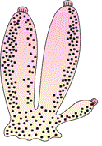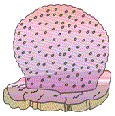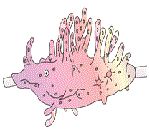The phylum :Porifera
The animals of this phylum are commonly called sponges and they are usually marine and mostly asymmetrical animals.
The word Porifera menas “pori” = pores and “fera” = bearers
Organization Level : Cellular
Coelom : Absent
Respiratory system : absent
Digestive system : absent
Circulatory System : Absent
These are primitive multicellular animals having cellular level of organisation. Sponges have a water transport or canal system. The water enters through ostia in the body wall into a central cavity, spongocoel, from where it goes out through the osculum. This pathway of water transport is helpful in food gathering, respiratory exchange and removal of waste. Choanocytes or collar cells line the spongocoel and the canals. Digestion is intracellular. The body is supported by a skeleton made up of spicules or spongin fibres. Sexes are not separate (hermaphrodite), means eggs and sperms are produced by the same individual. Sponges reproduce asexually by fragmentation and sexually by formation of gametes. Fertilisation is internal and development is indirect having a larval stage which is morphologically distinct from the adult.
Example
| Sycon | Euspongia | Spongilla |
|---|---|---|
 |
 |
 |
Sycons are solitary or colonial marine sponges found in shallow waters attached to the rocks. Their body is cylindrical in shape with numerous spores. The radial canal is made up of flagellated cells. These species undergo both sexual and asexual mode of reproduction. |
Euspongia is found throughout the Mediterranean Sea to rocky surfaces. They have small openings that are elevated and have cone-shaped gaps called conules. A small mouth-like opening called oscula is present at the tip of the lobes. Their ectosomal skeleton has primary and secondary spongin fibers together form the conulose openings. They also have a choanosomal skeleton having a dark mesh of secondary fibers from which primary fibers arise. These primary fibers are made up of spongin and have other particles like sand grains and spicules and secondary fibers are made up of only spongin and no other particles present. The primary fibers : 50-100 nanometres in diameter The secondary fibers : 20-36 nanometres in diameter. |
Spongilla are largely found in ponds, streams, lakes growing on submerged plants and sticks. The body wall consists of a thin dermis provided with pores called Ostia. They possess a rhagon type canal system. They reproduce sexually as well as asexually. |
